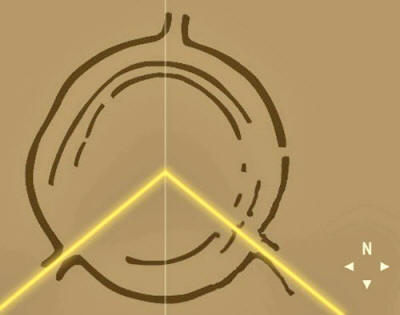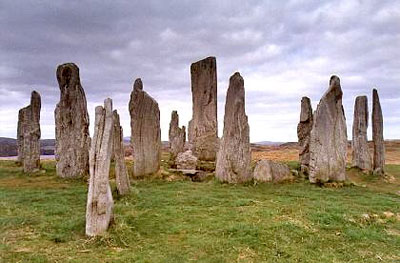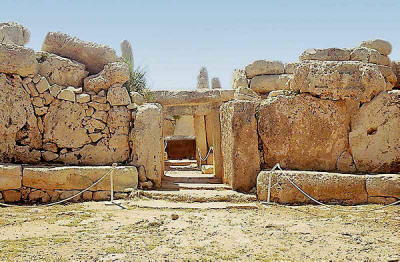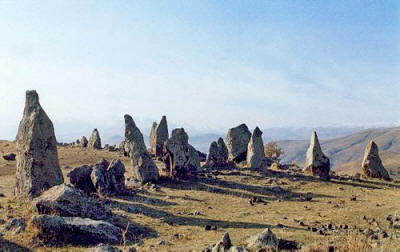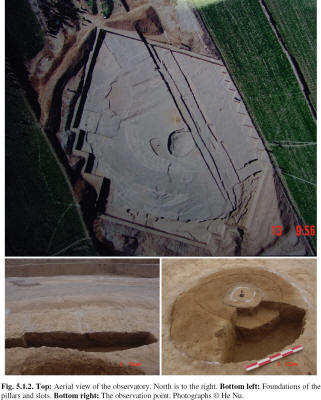|
by D.M. Murdock from Examiner Website
Every so often we read exciting headlines proclaiming that the "world's oldest this or that" has been discovered by archaeologists.
In 2005, for example, Chinese media declared that the "world's oldest observatory" had been found at Taosi in the Shanxi Province, dating to some 4,100 years ago.
Other recently discovered sites have also been pronounced the "world's oldest astronomical observatory," including one in Goseck (below), Germany, that was founded almost 7,000 years ago and that likewise is astronomically aligned, causing it to be called a "sun temple" as well as the "German Stonehenge."
In the past century or so, the original Stonehenge itself has also vied for the title of "world's oldest observatory," with construction beginning around 4,000 to 5,000 years ago.
Older than Stonehenge too are the Standing Stones of Callanish (above) in Scotland, dating to around 2900-2600 BCE, which are aligned to the winter solstice and other phenomena.
In Egypt, we find the site of Nabta Playa (below), some 6,000 to 8,000 years old and deemed,
Another astronomically aligned temple site is that of Mnajdra on Malta (below), parts of which date to nearly 6,000 years ago.
One of the oldest known sacred sites in the world, the 11,000-year-old ruins at Gobekli Tepe, Turkey - styled the "world's first temple" - may also prove to be astronomically aligned.
More recently, a site at Qarahunge in Armenia, also known as Zorats Karer (below), is likewise being claimed as the "world's oldest observatory," evidently dating to around 4,500 to 7,600 years ago, according to Armenian astronomer Paris Herouni.
This group of circles composed of hundreds of stones is said to be oriented the same as Stonehenge and to be,
Herouni further speculates that the ruins represent a temple to the sun god Ari.
Some of Herouni's contentions are backed
by Oxford University astrophysicist Mihran Vardanyan, the
leader of the joint expedition to Qaranunge by Oxford and the Royal
Geographical Society who asserts that Qarahunge represents the
"oldest observatory in the world."
This fact falls in line with ruins around the world that both are astronomically aligned and evidently served as religious sites or temples, thus revealing their astrotheological purpose, referring to the ancient worship or reverence of the sun, moon, planets, stars and constellations.
Case Study 5.1 - Taosi Observatory, China
The Chinese site possesses 13 sighting stones, with 12 gaps between, demonstrating a common theme found in many places and traditions reflecting the months of the year.
As the report relates,
Concerning
the Taosi site, we further
discover that "some of the astronomers believed that it might also
be used to observe the moon and stars," another common development
at locations globally dating back thousands of years.
The site also measures various lunar observations, all in a religious context, once again revealing ancient astrotheology.
The same can be said of the complex
"astronomical computer" of Stonehenge, which likewise evidently
served as both observatory and temple, as did many other such
ancient archaeological sites around the British Isles and the rest
of the world.
Another of the team's scientists, Nicholas Howarth, further commented:
As we can see even from this crude yet
purposeful construction in Armenia, the ancients evidently felt
compelled to mark these significant times of the year, in an
apparently religious context, indicating just how important they
were. Archaeological site at Gobekli Tepe
Turkey, c. 11,000 years old (Wiki Commons)
From cave paintings, statuary, "calendar sticks" and other artifacts dating to tens of thousands of years ago, we know that even more ancient cultures possessed important astronomical knowledge.
Many of these artifacts also appear to have religious value as well, additionally pushing the astrotheological religion back by millennia.
Moreover, as indicated by the fact that
there is apparently another site some 50 miles from Gobekli Tepe
dating to the same era, it is clear that we have only discovered the
tip of the iceberg of humanity's long and fascinating journey on
planet Earth.
|

